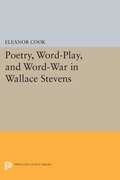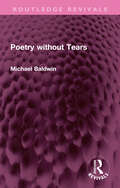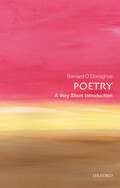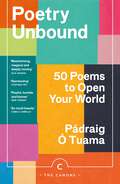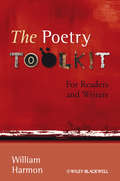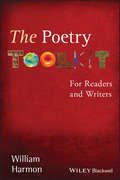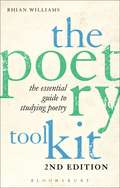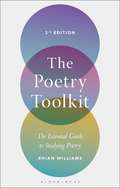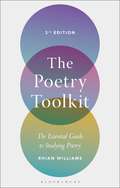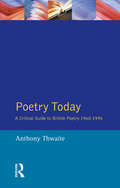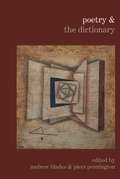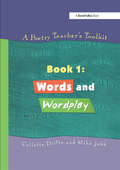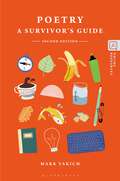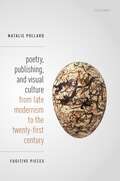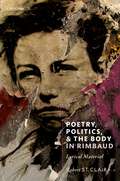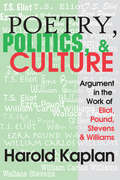- Table View
- List View
Poetry, Word-Play, and Word-War in Wallace Stevens
by Eleanor CookIn the first full-length study of Wallace Stevens's word-play, Eleanor Cook focuses on Stevens's skillful play with grammar, etymology, allusion, and other elements of poetry, and suggests ways in which this play offers a method of approaching his work. At the same time, this book is a general study of Stevens's poetry, moving from his earliest to his latest work, and includes close readings of three of his remarkable long poems--Esthetique du Mal, Notes toward a Supreme Fiction, and An Ordinary Evening in New Haven. The chronological arrangement enables readers to follow Stevens's increasing skill and changing thought in three areas of his "poetry of the earth": the poetry of place, the poetry of eros, and the poetry of belief.Poetry, Word-Play, and Word-War in Wallace Stevens shows how, in setting words at play and in conflict, Stevens could upset the usual relations of rhetoric, grammar, and dialectic, and thus the book contributes to the current debate about logical and a-logical uses of language. Cook also places Stevens within the larger context of Western literature, hearing how he speaks to Milton, Keats, and Wordsworth; to such American forebears as Whitman, Emerson, and Dickinson; and to T. S. Eliot, his contemporary.Originally published in 1988.The Princeton Legacy Library uses the latest print-on-demand technology to again make available previously out-of-print books from the distinguished backlist of Princeton University Press. These editions preserve the original texts of these important books while presenting them in durable paperback and hardcover editions. The goal of the Princeton Legacy Library is to vastly increase access to the rich scholarly heritage found in the thousands of books published by Princeton University Press since its founding in 1905.
Poetry without Tears (Routledge Revivals)
by Michael BaldwinFirst published in 1959, Poetry without Tears is a book not about what poetry is. The author argues that this book is not concerned with the educational resurrection of a dead art but about the artistic resurrection of education. Poetry is a force released in activity. That is how an educationalist and a poet see it. It is rarely how critics and academics see it. They see it as a series of poems, correspondingly it is as a ‘Collection of Poems’ that it is taught. Basic educational truths are frequently overlooked in our teaching of the arts, and no art suffers more from this than poetry. Baldwin goes on to say that in the end teaching is a creative activity and the creators are the best teachers. This book is a must read for students of both literature and education.
Poetry without Tears (Routledge Revivals)
by Michael BaldwinFirst published in 1959, Poetry without Tears is a book not about what poetry is. The author argues that this book is not concerned with the educational resurrection of a dead art but about the artistic resurrection of education. Poetry is a force released in activity. That is how an educationalist and a poet see it. It is rarely how critics and academics see it. They see it as a series of poems, correspondingly it is as a ‘Collection of Poems’ that it is taught. Basic educational truths are frequently overlooked in our teaching of the arts, and no art suffers more from this than poetry. Baldwin goes on to say that in the end teaching is a creative activity and the creators are the best teachers. This book is a must read for students of both literature and education.
Poetry: A Very Short Introduction (Very Short Introductions)
by Bernard O'DonoghuePoetry, arguably, has a greater range of conceptual meaning than perhaps any other term in English. At the most basic level everyone can recognise it—it is a kind of literature that uses special linguistic devices of organization and expression for aesthetic effect. However, far grander claims have been made for poetry than this—such as Shelley's that the poets 'are the unacknowledged legislators of the world', and that poetry is 'a higher truth'. In this Very Short Introduction, Bernard O'Donoghue provides a fascinating look at the many different forms of writing which have been called 'poetry'—from the Greeks to the present day. As well as questioning what poetry is, he asks what poetry is for, and considers contemporary debates on its value. Is there a universality to poetry? And does it have a duty of public utility and responsibility? ABOUT THE SERIES: The Very Short Introductions series from Oxford University Press contains hundreds of titles in almost every subject area. These pocket-sized books are the perfect way to get ahead in a new subject quickly. Our expert authors combine facts, analysis, perspective, new ideas, and enthusiasm to make interesting and challenging topics highly readable.
Poetry Unbound: 50 Poems to Open Your World (Canons)
by Pádraig Ó TuamaThis inspiring collection, curated by the host of the Poetry Unbound, presents fifty poems about what it means to be alive in the world today. Each poem is paired with Pádraig’s illuminating commentary that offers personal anecdotes and generous insights into the content of the poem. Engaging, accessible and inviting, Poetry Unbound is the perfect companion for everyone who loves poetry and for anyone who wants to go deeper into poetry but doesn’t necessarily know how to do so. Contributors include Hanif Abdurraqib, Patience Agbabi, Raymond Antrobus, Margaret Atwood, Ada Limón, Kei Miller, Roger Robinson, Lemn Sissay, Layli Long Soldier and more.
The Poetry Toolkit: For Readers and Writers
by William HarmonThe Poetry Toolkit: For Readers and Writers provides students with the essential intellectual and practical tools necessary to read, understand, and write poetry. Explains the most important elements of poetry in clear language and an easily accessible manner Offers readers both the expertise of an established scholar and the insights of a practicing poet Draws on examples from more than 1,500 years of English literature
The Poetry Toolkit: For Readers and Writers
by William HarmonThe Poetry Toolkit: For Readers and Writers provides students with the essential intellectual and practical tools necessary to read, understand, and write poetry. Explains the most important elements of poetry in clear language and an easily accessible manner Offers readers both the expertise of an established scholar and the insights of a practicing poet Draws on examples from more than 1,500 years of English literature
The Poetry Toolkit: 2nd Edition
by Rhian WilliamsWith examples from an extensive range of poets from Chaucer to today, The Poetry Toolkit offers simple and clear explanations of key terms, genres and concepts that enable readers to develop a richer, more sophisticated approach to reading, thinking and writing about poems. Combining an easy-to-use reference format defining and illustrating key concepts, forms and topics, with in-depth practice readings and further exercises, the book helps students master the study of poetry for themselves. Now in its second edition, The Poetry Toolkit includes a wider range of examples from contemporary poetry and more American poetry. In addition, an extended close reading section now offers practice comparative readings of the kind students are most likely to be asked to undertake, as well as readings informed by contemporary environmental and urban approaches. The book is also supported by extensive online resources, including podcasts, weblinks, guides to further reading and advanced study guides to reading poetry theoretically.
The Poetry Toolkit: The Essential Guide to Studying Poetry
by Rhian WilliamsNow thoroughly revamped with a diverse selection of poetic voices from the last fifty years, this third edition of Rhian Williams's bestselling book, The Poetry Toolkit guides readers through key terms, genres and concepts that help them to develop a richer, more sophisticated approach to reading, thinking and writing about poetry. Combining an easy-to-use reference format with in-depth practice readings and further exercises, the book helps students master the study of poetry for themselves. As well as featuring more contemporary voices, the 3rd edition of The Poetry Toolkit includes an expanded practical section giving guidance on close reading, comparative reading and advice on writing critically about poetry. In addition, the book is accompanied by a companion website offering audio recordings of poetry readings, weblinks and overviews of key theoretical approaches to support advanced study. Head to bloomsbury.com/Williams-the-poetry-toolkit for a host of additional resources.
The Poetry Toolkit: The Essential Guide to Studying Poetry
by Rhian WilliamsNow thoroughly revamped with a diverse selection of poetic voices from the last fifty years, this third edition of Rhian Williams's bestselling book, The Poetry Toolkit guides readers through key terms, genres and concepts that help them to develop a richer, more sophisticated approach to reading, thinking and writing about poetry. Combining an easy-to-use reference format with in-depth practice readings and further exercises, the book helps students master the study of poetry for themselves. As well as featuring more contemporary voices, the 3rd edition of The Poetry Toolkit includes an expanded practical section giving guidance on close reading, comparative reading and advice on writing critically about poetry. In addition, the book is accompanied by a companion website offering audio recordings of poetry readings, weblinks and overviews of key theoretical approaches to support advanced study. Head to bloomsbury.com/Williams-the-poetry-toolkit for a host of additional resources.
Poetry Today: A Critical Guide to British Poetry 1960-1995
by Anthony ThwaiteThis is the most authoritative and up to date survey of contemporary British poetry 1960-1995. It is the third version but second edition published by Longman of a successful survey that first appeared 30 years ago, and provides a succinct and accessible overview of British poets, movements and themes, ideal for English courses and the general reader alike.
Poetry Today: A Critical Guide to British Poetry 1960-1995
by Anthony ThwaiteThis is the most authoritative and up to date survey of contemporary British poetry 1960-1995. It is the third version but second edition published by Longman of a successful survey that first appeared 30 years ago, and provides a succinct and accessible overview of British poets, movements and themes, ideal for English courses and the general reader alike.
Poetry & the Dictionary (Poetry &... #8)
Poetry is an ancient verbal art, which has its roots in the oral epics and fragments that survive from classical times. Dictionaries of English, by contrast, are a comparatively recent phenomenon, beginning with the ‘hard words’ that Robert Cawdrey gathered in A Table Alphabeticall in 1604 and extending to the present edition of the Oxford English Dictionary, with its ongoing revisions. This innovative collection of essays is the first volume to explore the ways in which dictionaries have stimulated the imaginations of modern and contemporary poets from Britain, Ireland, and America, while also considering how poetry has itself been a rich source of material for lexicographers. As well as gauging the influence of major dictionaries like the OED, the essays single out encounters with more specialised works and broach uses of words that are not typically included in dictionaries. In doing so, the contributors not only cast familiar questions of ambiguity and etymology in a fresh light, but they also reveal a number of surprising and energising points of contact, from Hugh MacDiarmid’s rediscovery of Scots to Tina Darragh’s visual appropriations of dictionary pages. As such, Poetry & the Dictionary will prove an indispensable volume for all readers – academic or not – who find themselves fascinated by the language’s many involutions.
A Poetry Teacher's Toolkit: Book 1: Words and Wordplay
by Collette Drifte Mike JubbProfessional poets spend many hours crafting a finished piece of work, yet we expect children in school to sit down and write when they are told to, whether they feel inspired or not. This series of four books is a toolkit to help you build a positive framework for children to read, write, understand and enjoy poetry - to bring a creative spark to the poetry classroom. A combination of featured poems, creative ideas, structured lesson plans and differentiated photocopiable activity sheets gives the series a uniquely flexible approach - which means you can use the materials in any classroom context. If you're wary of poetry, if you think it's boring, or if you're nervous about teaching poetry, then you've chosen the right book. Key themes covered in BOOK 1: Words and Wordplay are playing with words; making patterns with words; words and meanings; puns and puzzles; how words affect readers; moods, feelings and attitudes; and how poets manipulate words. Other books in the series are: BOOK 2: Rhymes, Rhythms and Rattles; BOOK 3: Style, Shape and Structure; and BOOK 4: Language and Performance.
A Poetry Teacher's Toolkit: Book 1: Words and Wordplay
by Collette Drifte Mike JubbProfessional poets spend many hours crafting a finished piece of work, yet we expect children in school to sit down and write when they are told to, whether they feel inspired or not. This series of four books is a toolkit to help you build a positive framework for children to read, write, understand and enjoy poetry - to bring a creative spark to the poetry classroom. A combination of featured poems, creative ideas, structured lesson plans and differentiated photocopiable activity sheets gives the series a uniquely flexible approach - which means you can use the materials in any classroom context. If you're wary of poetry, if you think it's boring, or if you're nervous about teaching poetry, then you've chosen the right book. Key themes covered in BOOK 1: Words and Wordplay are playing with words; making patterns with words; words and meanings; puns and puzzles; how words affect readers; moods, feelings and attitudes; and how poets manipulate words. Other books in the series are: BOOK 2: Rhymes, Rhythms and Rattles; BOOK 3: Style, Shape and Structure; and BOOK 4: Language and Performance.
Poetry: A Survivor's Guide
by Mark YakichPoetry: A Survivor's Guide has earned high praise from students, teachers, and readers from around the globe for its playful sincerity and idiosyncratic humor and for its approach to a subject both loved and feared. Updated and expanded, including six new sections, the second edition probes a range of strategies for inspiring students and aspiring poets on the ways poetry relates to their own lives. These include the delights and pitfalls of individual meditation, the complications of identity and appropriation, and the uses and utility of poetry as a tool of social change.The second edition also includes a curated companion website for teachers, students, and aspiring poets that features poetry examples, writing prompts and exercises, and resources for publishing poetry.
Poetry: A Survivor's Guide
by Mark YakichPoetry: A Survivor's Guide has earned high praise from students, teachers, and readers from around the globe for its playful sincerity and idiosyncratic humor and for its approach to a subject both loved and feared. Updated and expanded, including six new sections, the second edition probes a range of strategies for inspiring students and aspiring poets on the ways poetry relates to their own lives. These include the delights and pitfalls of individual meditation, the complications of identity and appropriation, and the uses and utility of poetry as a tool of social change.The second edition also includes a curated companion website for teachers, students, and aspiring poets that features poetry examples, writing prompts and exercises, and resources for publishing poetry.
Poetry The Student Toolkit Literary Eye GCSE English Second Edition (PDF)
by Steve EddyThe student guide to how poetry works and responding to poetry.
Poetry & Strikes: Trade Union Narratives and Legacies (Poetry &... #12)
by Michael JamesPoetry & Strikes examines shifting representations of strike action in the work of six British poets from the 1970s to the present day. It considers how these poets have come to contend with, and contribute to, narratives surrounding industrial disputes. Through these conversations, the book attempts to question the way in which union narratives and legacies are constructed, and to investigate the power dynamics that underpin the presentation of labour histories. The work of these poets helps us to understand how cultural memories have been formed, and makes it possible to see how these legacies may still be rewritten and reframed.
Poetry, Publishing, and Visual Culture from Late Modernism to the Twenty-first Century: Fugitive Pieces
by Natalie PollardThis is a book about contemporary literary and artistic entanglements: word and image, media and materiality, inscription and illustration. It proposes a vulnerable, fugitive mode of reading poetry, which defies disciplinary categorisations, embracing the open-endedness and provisionality of forms. This manifests itself interactively in the six case studies, which have been chosen for their distinctness and diversity across the long twentieth century: the book begins with the early twentieth-century work of writer and artist Djuna Barnes, exploring her re-animation of sculptural and dramatic sources. It then turns to the late modernist artist and poet David Jones considering his use of the graphic and plastic arts in The Anathemata, and next, to the underappreciated mid-century poet F.T. Prince, whose work uncannily re-activates Michelangelo's poetry and sculpture. The second half of the book explores the collaborations of the canonical poet Ted Hughes with the publisher and artist Leonard Baskin during the 1970s; the innovative late twentieth-century poetry of Denise Riley who uses page space and embodied sound as a form of address; and, finally, the contemporary poet Paul Muldoon who has collaborated with photographers and artists, as well as ventriloquising nonhuman phenomena. The resulting unique study offers contemporary writers and readers a new understanding of literary, artistic, and nonhuman practices and shows the cultural importance of engaging with their messy co-dependencies. The book challenges critical methodologies that make a sharp division between the textual work and the extra-literary, and raises urgent questions about the status and autonomy of art and its social role.
Poetry, Publishing, and Visual Culture from Late Modernism to the Twenty-first Century: Fugitive Pieces
by Natalie PollardThis is a book about contemporary literary and artistic entanglements: word and image, media and materiality, inscription and illustration. It proposes a vulnerable, fugitive mode of reading poetry, which defies disciplinary categorisations, embracing the open-endedness and provisionality of forms. This manifests itself interactively in the six case studies, which have been chosen for their distinctness and diversity across the long twentieth century: the book begins with the early twentieth-century work of writer and artist Djuna Barnes, exploring her re-animation of sculptural and dramatic sources. It then turns to the late modernist artist and poet David Jones considering his use of the graphic and plastic arts in The Anathemata, and next, to the underappreciated mid-century poet F.T. Prince, whose work uncannily re-activates Michelangelo's poetry and sculpture. The second half of the book explores the collaborations of the canonical poet Ted Hughes with the publisher and artist Leonard Baskin during the 1970s; the innovative late twentieth-century poetry of Denise Riley who uses page space and embodied sound as a form of address; and, finally, the contemporary poet Paul Muldoon who has collaborated with photographers and artists, as well as ventriloquising nonhuman phenomena. The resulting unique study offers contemporary writers and readers a new understanding of literary, artistic, and nonhuman practices and shows the cultural importance of engaging with their messy co-dependencies. The book challenges critical methodologies that make a sharp division between the textual work and the extra-literary, and raises urgent questions about the status and autonomy of art and its social role.
Poetry, Politics, and the Body in Rimbaud: Lyrical Material
by Robert St. ClairBodies abound in Rimbaud's poetry in a way that is nearly unprecedented in the nineteenth-century poetic canon: lazy, creative, rule-breaking bodies, queer bodies, marginalized and impoverished bodies, revolting and revolutionary, historical bodies. The question that Poetry, Politics, and the Body seeks to answer is: What does this corporeal density mean for reading Rimbaud? What kind of sense are we to make of this omnipresence of the body in the Rimbaldian corpus, from first to last–from the earliest poems in verse celebrating the sheer, simple delight of running away from wherever one is and stretching one's legs out under a table, to the ultimate flight away from poetry itself? In response, this book argues that the body appears–often literally–as a kind of gap, breach, or aperture through which Rimbaud's poems enter into contact with history and a larger body of other texts. Simply put, the body is privileged 'lyrical material' for Rimbaud: a figure for human beings in their exposed, finite creatureliness and in their unpredictable agency and interconnectedness. Its presence in the early work allows us not only to contemplate what a strange, sensuous thing it is to be embodied, to be both singular and part of a collective, it also allows the poet to diagnose, and the reader to perceive, a set of seemingly intractable, 'real' socio-economic, political, and symbolic problems. Rimbaud's bodies are, in other words, utopian bodies: sites where the historical and the lyrical, the ideal and the material, do not so much cancel each other out as become caught up in one another.
Poetry, Politics, and the Body in Rimbaud: Lyrical Material
by Robert St. ClairBodies abound in Rimbaud's poetry in a way that is nearly unprecedented in the nineteenth-century poetic canon: lazy, creative, rule-breaking bodies, queer bodies, marginalized and impoverished bodies, revolting and revolutionary, historical bodies. The question that Poetry, Politics, and the Body seeks to answer is: What does this corporeal density mean for reading Rimbaud? What kind of sense are we to make of this omnipresence of the body in the Rimbaldian corpus, from first to last–from the earliest poems in verse celebrating the sheer, simple delight of running away from wherever one is and stretching one's legs out under a table, to the ultimate flight away from poetry itself? In response, this book argues that the body appears–often literally–as a kind of gap, breach, or aperture through which Rimbaud's poems enter into contact with history and a larger body of other texts. Simply put, the body is privileged 'lyrical material' for Rimbaud: a figure for human beings in their exposed, finite creatureliness and in their unpredictable agency and interconnectedness. Its presence in the early work allows us not only to contemplate what a strange, sensuous thing it is to be embodied, to be both singular and part of a collective, it also allows the poet to diagnose, and the reader to perceive, a set of seemingly intractable, 'real' socio-economic, political, and symbolic problems. Rimbaud's bodies are, in other words, utopian bodies: sites where the historical and the lyrical, the ideal and the material, do not so much cancel each other out as become caught up in one another.
Poetry, Politics, and Culture: Argument in the Work of Eliot, Pound, Stevens, and Williams
by Harold KaplanA salient feature of modern poetics is its direct connection with cultural history and politics. Among the great American poets of the twentieth century, Wallace Stevens and William Carlos Williams offer a significant contrast with T. S. Eliot and Ezra Pound. Where the latter advocated a theocentric or reactionary response to the cultural crises of modernity, the former affirmed an essentially humanist and democratic social and aesthetic ethos. In Poetry, Politics, and Culture, Harold Kaplan offers a penetrating comparative study of these representative and distinctively influential poets.All four poets wrote in an atmosphere of cultural crisis following World War I, caught as they were between outmoded belief systems and various forms of artistic and political nihilism. While each believed in poetry as a source of cultural values and beliefs, they nevertheless experienced loss of confidence in their own vocation in a world characterized by scientific, rationalist thinking and the mundane struggle for survival. For each, therefore, the poetic imagination was a means of restoring order, or building a new civilization out of chaos. In trying to define a revitalized culture, the four exemplified the perennial quarrel between Europe and America.
Poetry, Politics, and Culture: Argument in the Work of Eliot, Pound, Stevens, and Williams
by Harold KaplanA salient feature of modern poetics is its direct connection with cultural history and politics. Among the great American poets of the twentieth century, Wallace Stevens and William Carlos Williams offer a significant contrast with T. S. Eliot and Ezra Pound. Where the latter advocated a theocentric or reactionary response to the cultural crises of modernity, the former affirmed an essentially humanist and democratic social and aesthetic ethos. In Poetry, Politics, and Culture, Harold Kaplan offers a penetrating comparative study of these representative and distinctively influential poets.All four poets wrote in an atmosphere of cultural crisis following World War I, caught as they were between outmoded belief systems and various forms of artistic and political nihilism. While each believed in poetry as a source of cultural values and beliefs, they nevertheless experienced loss of confidence in their own vocation in a world characterized by scientific, rationalist thinking and the mundane struggle for survival. For each, therefore, the poetic imagination was a means of restoring order, or building a new civilization out of chaos. In trying to define a revitalized culture, the four exemplified the perennial quarrel between Europe and America.
